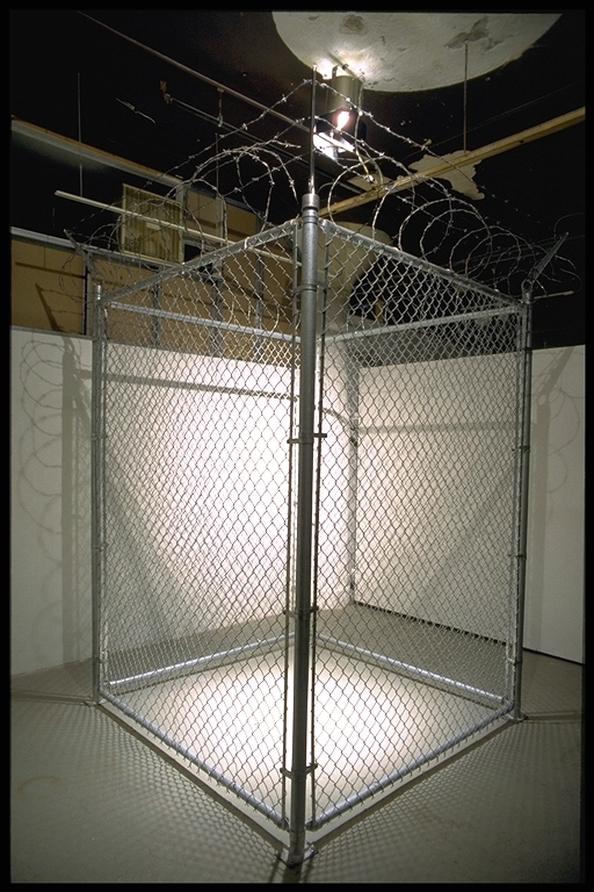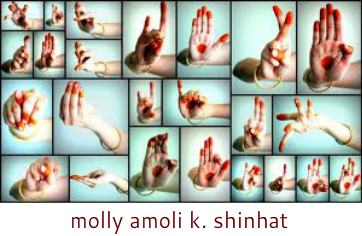Workers in Progress
Enriched Bread Artists allows public a peak over the fence
7th Annual Open Studio
Andrée Amarica, John R. Barkley, Karen Jordon Bowie, Barbara Brown, Audrey Churgin,
Carol Devine, Tara Donaghy, Kenneth Emig, Barbara Gamble, Eliza Griffiths, Danny Hussey,
Marika Jemma, Gayle Kells, Mary Lugli, Sheryl Luxenburg, Elbagir Osman, Christos Pantieras,
Mary Pfaff, Uta Riccius, Phil Rose, Cindy Stelmackowich, Carl Stewart, Svetlana Swinimer
The Bread Factory

Impressions of My Summer Vacation, Kenneth Emig, 1999. Photo copyright Kenneth Emig
Direct interaction with artists doesn't occur that often. Whirling through a funereal vernissage (anointed attendees usually show up in black), the artist sips some bad wine, chitchats with a couple of VIPs or BPs, and heads off home or to the next engagement. Enriched Bread Artists (EBA) 7th Annual Open Studio comes as a brief but stellar relief. Spilling through two floors of studios and common areas, the Open Studio is a chance for viewers to meet the artists, see new work - in the common areas - and older work or work-in-progress in the hastily cleaned-up studios. Eliza Griffiths portraits of anxiety-ridden people, Svetlana Swinimer and Jean Halstead's chilling installation, and Cindy Stelmackowich's pantyhose sculptures are just a few of the notable offerings.
"It's a great opportunity," says Carl Stewart. "I learn from people who come in. They see things in my work I may not see." A textile artist, Stewart's new work, "Blue for Boys", boldly goes where no textile artist has gone before. Using hard-core images from gay-porn web sites, he transforms them into woven tapestries. The metamorphosis from disposable net-porn to enduring tapestries utterly shifts the images' meaning. Taking over 300 hours to complete, one tapestry shows a young man, rippling with muscles (and another endowment), striking an archetypal pose of gay male porn - arms folded across the chest, staring straight at the viewer. With a little skintight T-shirt on, naked from the waist-down, Stewart portrays him in varying shades of blue, using the Five Roses Flour Company's trademark rose to wallpaper the background. The combination is quite electrifying, to say the least (If he could see Stewart's tapestry, what would the young man make of it?). "Men are the object of my desire," says Stewart. (Carl, I'd never've guessed.)
At approximately 3' by 7', the young man appears as big, strong and sexy as the male figures Michaelangelo produced. But here Stewart forces us to confront gay male sexuality in all its naked glory. There's no violence and no degradation in the imagery yet its source raises a series of paradoxes. "It's a reclaiming," says Stewart. "The guy who's getting fucked is smiling! He's having a good time!" he adds of another more explicit work. Stewart suggests that through touch, textiles offer a fulfilment that computers cannot provide, and yet can touching an object replace the touch of another human being? New technology is already being tested that reconfigures a computer mouse to produce digitally generated "virtual" tactile sensations. A major application for this technology, paradoxically, is pornographic web sites.
Focusing on the daily litanies of mass media, Mary Lugli sets up her installation "All in a Day's Wash" in a common area. Consisting of a drawing and a T-shirt plastered with newspaper clippings, she took the theme of bankruptcy as a point of departure. In the drawing, she uses words like "who cares" transposed over a drawing of Monica's ejaculate-stained dress, "whatever" over an Eaton's T-shirt, "Here" over a camouflage jacket where the camouflage pattern makes a map showing Kosovo's location, questioning the relevance of the information we're assaulted with. Taking as a symbol the human heart, "Symphony in Three Movements" 1999 in Lugli's studio combines Stravinsky's symphony of the same name, a recording of her own heartbeat, pictures and sculpture. "First Aid for a Broken Heart" features anatomical drawings along with steps for recovery. "Step 1 Proceed with caution so that you don't become the second victim" ominously proceeds through to "Step 7 Give the casualty chocolate, NEVER ALCOHOL."
Referencing Stravinsky's symphony as "expressing his impressions of World War II", Lugli transposes those themes over the ravaged battlefields of the heart. In a large drawing, "MOVE IN", "MOVE OUT", "MOVE ON" and a heart-rate monitor's line jerking across the lower portion of the picture, mirror the militaristic language and heightened surveillance inherent in the state of war itself.
Provisionally titled, "Impressions of my Summer Vacation, 1999", Kenneth Emig's installation stands galaxies away from those "what I did on my summer vacation" essays we all wrote in school. An 8'-high chain-link gate-less fence bolted to the floor, topped by a foot of barbwire, completely encloses a 6' square space. Driven by his most recent trip to Los Angeles, Emig's work explores the unacknowledged territories around segregation and urban planning. When cities start using things like razor wire to "secure" parking lots, "what are you really saying?" questions Emig. "Are you saying that you need it for your own security or to protect your 'stuff'? Who is it really for?" Sitting next to a tall fenced-in space with no way in or out (except over the barb-wire) was creepy enough, imagining it filled with the normal creature comforts of day-to-day life made it worse. "Maybe a sofa, some books a lamp, maybe even a bit of carpet," says Emig, still debating what to put inside it.
Emig's work emits signals much like a probe in outer space that generate more questions than answers about our complicity in the structuring of our landscapes. The metaphor could be applied to any aspect of the human condition where difference is turned into a wall or a weapon—race, age, gender, religion, or sexual preference for instance. Emig's work turns a Quartz-light onto the fence—literally, how we construct ourselves, where I end and you begin—and what those constructions shut us off from. That, and to consider carefully: are our fences defences or prisons?
Published in The Ottawa Xpress, 2000
"It's a great opportunity," says Carl Stewart. "I learn from people who come in. They see things in my work I may not see." A textile artist, Stewart's new work, "Blue for Boys", boldly goes where no textile artist has gone before. Using hard-core images from gay-porn web sites, he transforms them into woven tapestries. The metamorphosis from disposable net-porn to enduring tapestries utterly shifts the images' meaning. Taking over 300 hours to complete, one tapestry shows a young man, rippling with muscles (and another endowment), striking an archetypal pose of gay male porn - arms folded across the chest, staring straight at the viewer. With a little skintight T-shirt on, naked from the waist-down, Stewart portrays him in varying shades of blue, using the Five Roses Flour Company's trademark rose to wallpaper the background. The combination is quite electrifying, to say the least (If he could see Stewart's tapestry, what would the young man make of it?). "Men are the object of my desire," says Stewart. (Carl, I'd never've guessed.)
At approximately 3' by 7', the young man appears as big, strong and sexy as the male figures Michaelangelo produced. But here Stewart forces us to confront gay male sexuality in all its naked glory. There's no violence and no degradation in the imagery yet its source raises a series of paradoxes. "It's a reclaiming," says Stewart. "The guy who's getting fucked is smiling! He's having a good time!" he adds of another more explicit work. Stewart suggests that through touch, textiles offer a fulfilment that computers cannot provide, and yet can touching an object replace the touch of another human being? New technology is already being tested that reconfigures a computer mouse to produce digitally generated "virtual" tactile sensations. A major application for this technology, paradoxically, is pornographic web sites.
Focusing on the daily litanies of mass media, Mary Lugli sets up her installation "All in a Day's Wash" in a common area. Consisting of a drawing and a T-shirt plastered with newspaper clippings, she took the theme of bankruptcy as a point of departure. In the drawing, she uses words like "who cares" transposed over a drawing of Monica's ejaculate-stained dress, "whatever" over an Eaton's T-shirt, "Here" over a camouflage jacket where the camouflage pattern makes a map showing Kosovo's location, questioning the relevance of the information we're assaulted with. Taking as a symbol the human heart, "Symphony in Three Movements" 1999 in Lugli's studio combines Stravinsky's symphony of the same name, a recording of her own heartbeat, pictures and sculpture. "First Aid for a Broken Heart" features anatomical drawings along with steps for recovery. "Step 1 Proceed with caution so that you don't become the second victim" ominously proceeds through to "Step 7 Give the casualty chocolate, NEVER ALCOHOL."
Referencing Stravinsky's symphony as "expressing his impressions of World War II", Lugli transposes those themes over the ravaged battlefields of the heart. In a large drawing, "MOVE IN", "MOVE OUT", "MOVE ON" and a heart-rate monitor's line jerking across the lower portion of the picture, mirror the militaristic language and heightened surveillance inherent in the state of war itself.
Provisionally titled, "Impressions of my Summer Vacation, 1999", Kenneth Emig's installation stands galaxies away from those "what I did on my summer vacation" essays we all wrote in school. An 8'-high chain-link gate-less fence bolted to the floor, topped by a foot of barbwire, completely encloses a 6' square space. Driven by his most recent trip to Los Angeles, Emig's work explores the unacknowledged territories around segregation and urban planning. When cities start using things like razor wire to "secure" parking lots, "what are you really saying?" questions Emig. "Are you saying that you need it for your own security or to protect your 'stuff'? Who is it really for?" Sitting next to a tall fenced-in space with no way in or out (except over the barb-wire) was creepy enough, imagining it filled with the normal creature comforts of day-to-day life made it worse. "Maybe a sofa, some books a lamp, maybe even a bit of carpet," says Emig, still debating what to put inside it.
Emig's work emits signals much like a probe in outer space that generate more questions than answers about our complicity in the structuring of our landscapes. The metaphor could be applied to any aspect of the human condition where difference is turned into a wall or a weapon—race, age, gender, religion, or sexual preference for instance. Emig's work turns a Quartz-light onto the fence—literally, how we construct ourselves, where I end and you begin—and what those constructions shut us off from. That, and to consider carefully: are our fences defences or prisons?
Published in The Ottawa Xpress, 2000

